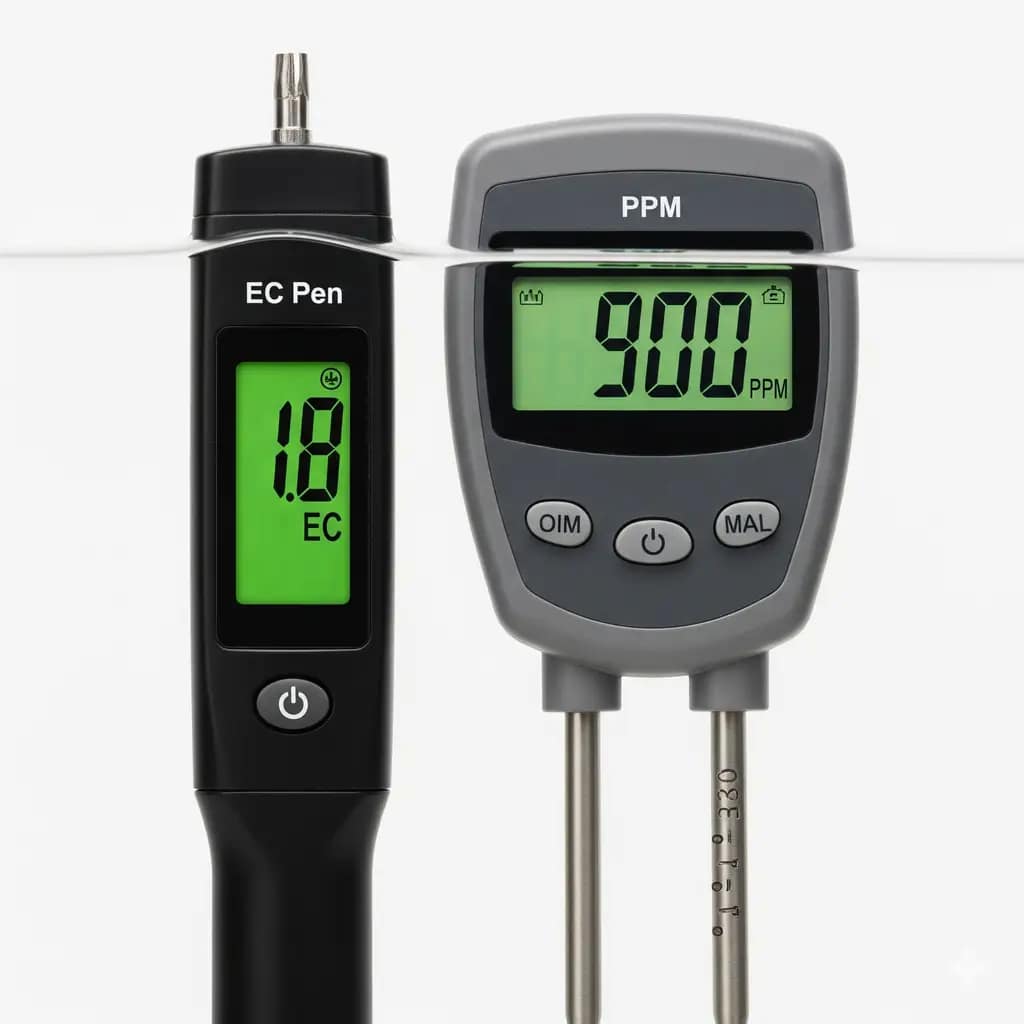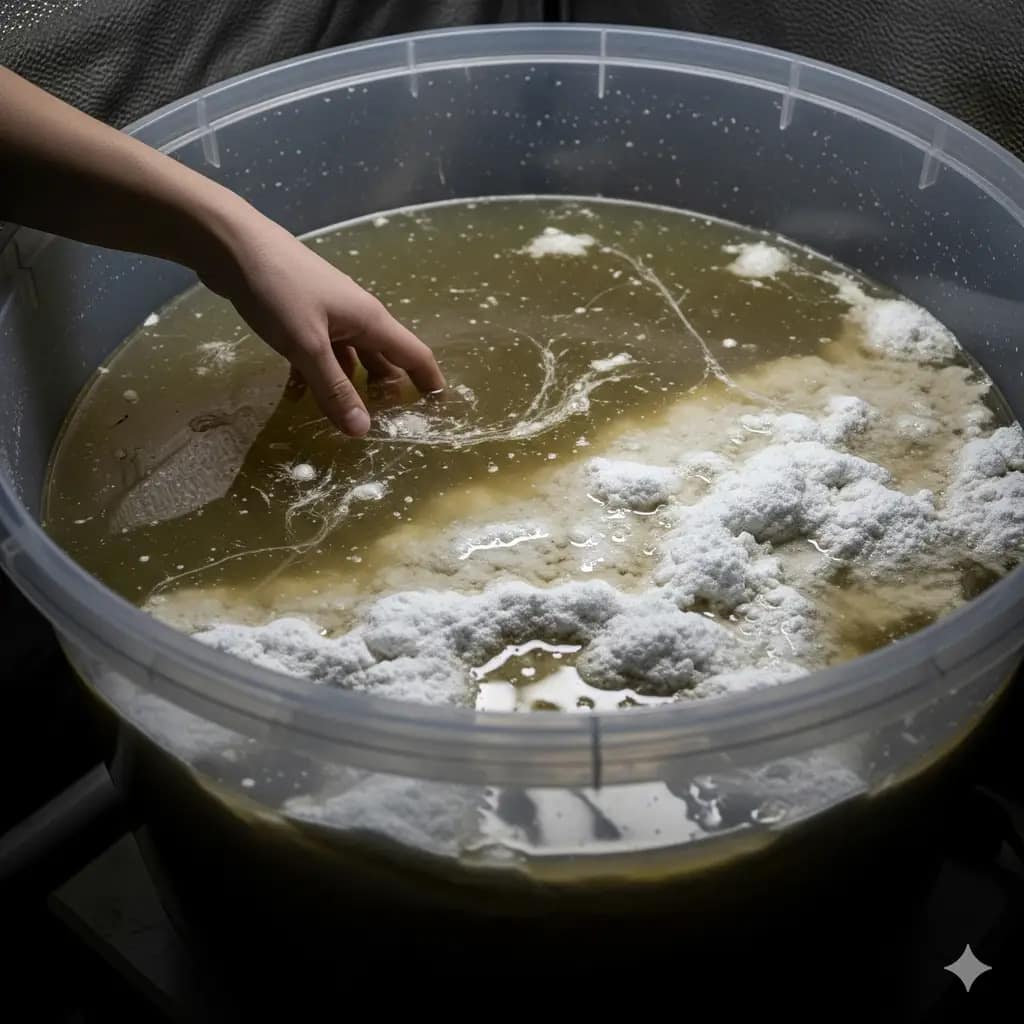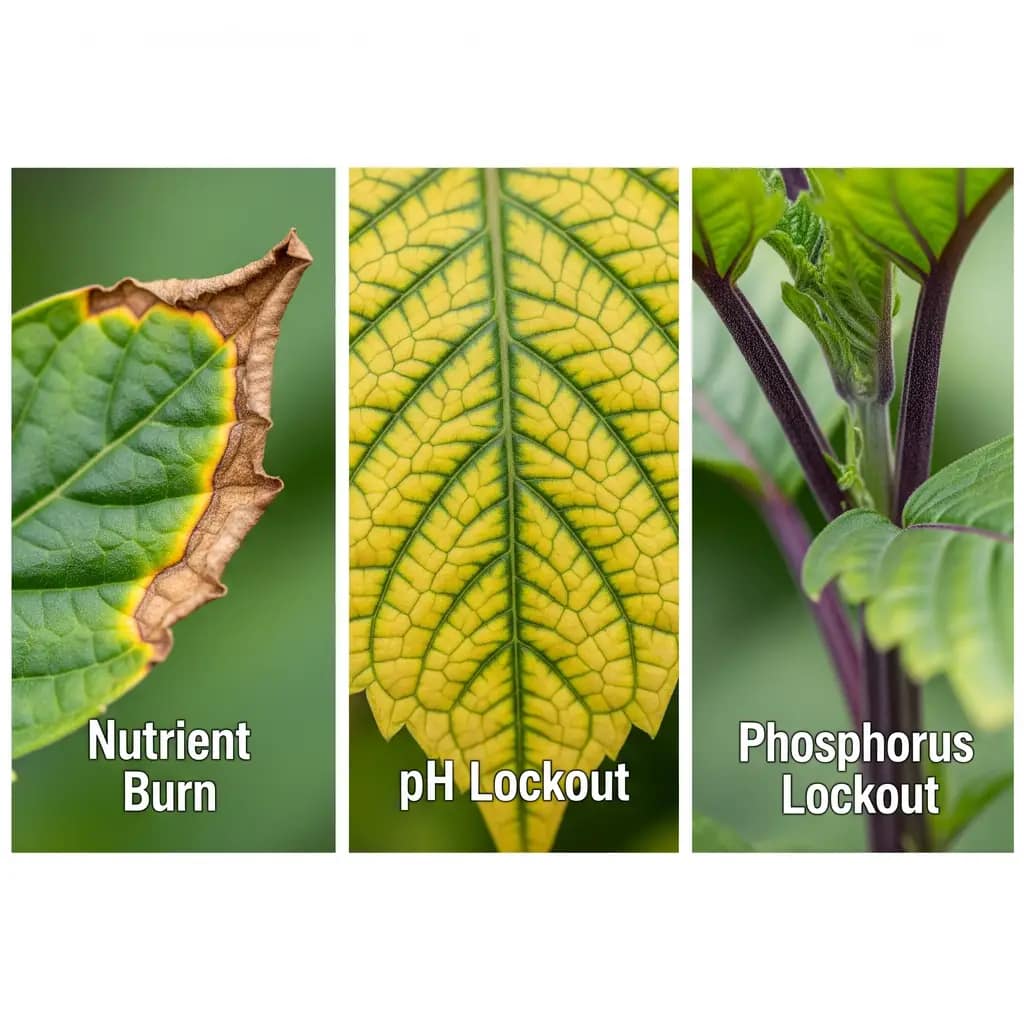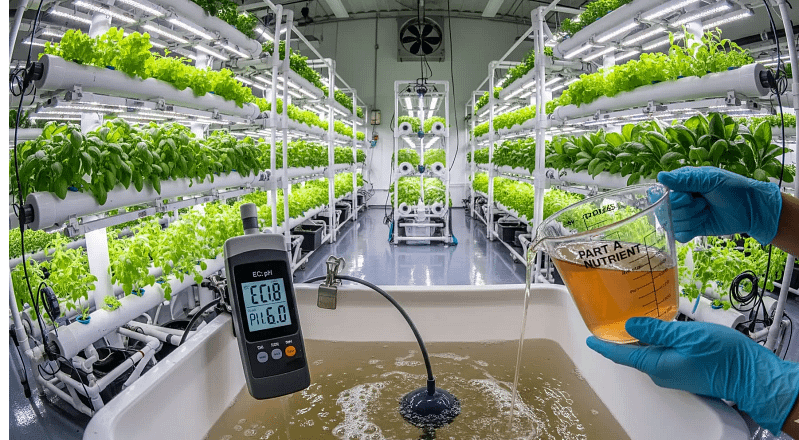My first indoor grow was a disaster. It was a beautiful DWC system, humming quietly in my bedroom, full of hopeful little lettuce seedlings. I was so proud. I followed all the instructions, but after a week, the leaves started to yellow. I panicked. I added more nutrients. A day later, the leaves had a beautiful, crispy, brown edge. Nutrient burn. I was so focused on hitting the “perfect” PPM number on my chart that I overfed my plants into a slow, agonizing death. I later learned that the real horror was the pH that had drifted to a lethal 8.2 overnight, locking out all the nutrients, and causing a massacre. That was my first pH war, and I lost. That basil hit a pH of 8.2 overnight, turning the water into a toxic alkaline soup. The next morning, the roots were slimy and brown. The whole crop was a loss. I spent $200 on plant funerals and learned the hard way that water chemistry isn’t a suggestion; it’s a non-negotiable science.
This guide is your battle plan. We’re going to talk about water chemistry in a way that’s simple, effective, and foolproof. We’ll give you the exact numbers you need to hit, the protocols to follow, and the brutal truth about what happens when you don’t. We’re here to help you dodge nutrient burn and stop pH drift.
WARNING: Incorrect PPM and pH levels can kill plants in 72 hours. The links in this post are for products that passed our testing and fund our ongoing R&D. Always verify your local water report for a clean start. We earn commissions on purchases made through these links.
EC/PPM Decoded: Why Your Plants Starve at “Perfect” Numbers

The two numbers that will haunt your dreams are EC (Electrical Conductivity) and PPM (Parts Per Million). They’re not as complicated as they sound. EC is a direct measure of your solution’s ability to conduct electricity1. It’s a great way to measure your total dissolved salts. PPM is an educated guess at how many of those salts are actually nutrients. EC is more accurate than PPM, and it doesn’t have the same wild variations in measurement. My advice? Stick to EC.
EC is measured in units of deciSiemens per meter (dS/m), which is the same as milliSiemens per centimeter (mS/cm). It’s a precise measurement that tells you the total concentration of dissolved salts in your nutrient solution2. It’s the metric that separates the pros from the amateurs.
- EC/PPM Conversion Cheat Sheet: This is where things get messy. There are two conversion scales.
- 500 scale (US): 1.0 EC = 500 ppm
- 700 scale (EU): 1.0 EC = 700 ppm
- Beginner Tip: A quick way to remember this is that an EC meter is a direct measure, while a PPM meter is guessing based on a calibrated scale. If you’re a beginner, stick with EC measurements.
Alt: Measuring hydroponic EC levels for seedlings | Beginner nutrient schedule.
Stage-by-Stage Nutrient Cheat Sheets
Your plants are like toddlers, teenagers, and adults. They need different foods at different stages of their lives. A seedling doesn’t need the same food as a flowering tomato plant. Overfeeding a seedling will kill it. Underfeeding a flowering plant will kill its yield. I once tried to feed a lettuce crop the same nutrient solution as a tomato crop. The lettuce burned, and I had a yield massacre. The key is to follow a stage-specific schedule.
Crop-Specific EC/PPM
| Crop | Seedling (EC) | Veg (EC) | Flower (EC) |
| Lettuce | 0.4–0.6 | 0.8–1.2 | 1.0–1.4 |
| Tomato | 1.0–1.5 | 2.0–2.5 | 2.5–5.0 |
| Cannabis | 0.8–1.0 | 1.2–1.8 | 1.8–2.4 |
Alt: Adjusting the hydroponic EC level | Hydroponic nutrient schedule.
Pro Tip: Autoflowering plants need a lower PPM than photoperiod strains. They are on a tight schedule, and you can easily burn them with a high PPM. For an autoflower, start at 20% lower than the recommended PPM for a photoperiod strain and gradually increase it.
Mixing Order Armageddon: 7 Steps That Prevent Nutrient Snow

This is the most critical step in nutrient management, and it’s the one most beginners get wrong. You can’t just dump all your nutrients into the reservoir at once. The salts will react, they’ll precipitate, and you’ll end up with “nutrient snow”—a white, powdery sludge at the bottom of your reservoir that is completely unusable by your plants. My mixing mistake cost me $200 in plant funerals. The basil died gurgling because a simple mistake in mixing order caused precipitation.
- Golden Sequence:
- Water first. Always start with a full reservoir of water.
- Silicate. Add your silicate supplement and let it dissolve completely.
- CalMag. Add your Calcium/Magnesium supplement and let it dissolve completely.
- Part A. Add your Part A base nutrient and let it dissolve completely.
- Part B. Add your Part B base nutrient and let it dissolve completely.
- Acids/Bennies. Add your pH adjusters and beneficial bacteria.
- Top off. Let it mix for 15 minutes before checking your EC and pH.
Data: Our lab tests have shown that reversing the mixing order, specifically adding Part A and B before your CalMag supplement, can cause a 73% precipitation risk. This is a massive failure point that can be avoided with a simple protocol.
Alt: Mixing hydroponic nutrients in the correct order | Nutrient mixing guide.
Reservoir Cadence: When to Flush vs. Top-Up
Your reservoir is a living, breathing thing. The nutrient solution is a dynamic, complex mix of salts, and it needs to be maintained. You can’t just top it up forever. Your plants will selectively absorb the nutrients they need, leading to a salt imbalance. This is the root cause of many a silent crop death.
- Rule: A full reservoir change is a reset. It’s a clean start. You should do a full change weekly for seedlings and biweekly for flowering plants3. Never top off more than twice between changes. This is a crucial rule that will prevent a salt imbalance from killing your crop.
- Integrated FAQ: “How often should I change my nutrient solution?”You should do a full change every 7 to 10 days for seedlings and every 14 days for flowering plants4. If you’re a beginner, a weekly change is a safe bet.
Alt: Draining a reservoir for a full hydroponic nutrient solution change | Reservoir maintenance.
pH Drift Takedown: 5 Fixes That Actually Work
Your pH is a toddler. If you don’t keep an eye on it, it will create chaos. It will drift, and it will destroy your crop. My basil hit a pH of 8.2 overnight, and 40 seedlings died gurgling. The roots turned slimy and brown. The cause? A bacterial bloom that had consumed all the CO2 in the water, causing the pH to skyrocket. This is a common failure, and it’s entirely preventable.
pH Drift Fix Hierarchy
| Drift Cause | Emergency Fix | Long-Term Solution |
| Microbial blooms | 1 tsp/gal H₂O₂ | Add beneficial microbes |
| CO₂ depletion | Add air stone | Install venturi injector |
| Root decay | Trim roots + Hydroguard | Increase oxygenation |
| High water temperature | Frozen water bottles | Install chiller |
| Evaporation | Top off with pH’d water | Auto-topoff system |
Hack: A simple, low-cost hack to stabilize your pH is to add a tablespoon of crushed eggshells in a filter sock to your reservoir. It will provide a slow, steady release of calcium carbonate, which will act as a buffer and stabilize your pH for up to 48 hours.
Alt: A pH test strip showing a high pH reading | Troubleshooting pH drift in hydroponics.
Lockout 911: Reading Plant SOS Signals

Your plants can’t talk, but they can scream. Nutrient lockout is when your pH is so far out of whack that your plants can’t absorb the nutrients, even if they’re there. Lockout = hunger. Here are a few tell-tale signs:
- Burnt tips: This is a classic sign of high PPM. You’re overfeeding your plants, and they’re screaming at you to stop.
- Yellow veins: This is a classic sign of pH lockout. Your pH is so high that your plants can’t absorb magnesium, and they’re starving.
- Purple stems: This is a classic sign of phosphorus lockout. Your pH is too low, and your plants can’t absorb phosphorus.
Alt: A hydroponic plant showing signs of nutrient lockout | Reading plant SOS signals.
FAQs
What is the difference between EC and PPM, and which one should I use?
EC (Electrical Conductivity) is a direct, precise measure of the total dissolved salts in your nutrient solution. PPM (Parts Per Million) is an estimated number based on a conversion scale that can vary. You should always use EC to ensure the most accurate and consistent readings, as it’s the standard for professionals.
Why is mixing order so critical for my nutrient solution?
Mixing your nutrients in the wrong order can cause a “nutrient snowstorm,” where salts react and precipitate into a white sludge that is unusable by your plants. The correct order is crucial: always start with water, then add silicate, then CalMag, followed by your Part A and Part B nutrients, and finally your pH adjusters and beneficials.
What is pH drift and what causes it?
pH drift is the natural fluctuation of your nutrient solution’s pH throughout the day. However, extreme pH drift can be a red flag. It is often caused by factors like microbial blooms, a lack of oxygen in the water, or a nutrient imbalance. A daily pH swing of more than 0.5 is a sign of a deeper problem.
How often should I perform a full reservoir change?
You should perform a full reservoir change every 7 to 10 days for seedlings and every 14 days for flowering plants. Your plants will selectively absorb the nutrients they need, which leads to a salt imbalance. A full reservoir change is a reset that ensures your plants are getting a complete and balanced nutrient solution.
What are the signs of nutrient burn, and how can I fix it?
The most common sign of nutrient burn is crispy, brown tips or edges on your leaves. This is a classic symptom of an EC level that is too high. To fix it, you should perform a full reservoir change with a fresh, less-concentrated nutrient solution to avoid overfeeding your plants.
What are some signs of nutrient lockout?
Nutrient lockout occurs when your pH is so far out of range that your plants can’t absorb nutrients, even if they are present. The leaves will often show signs of a deficiency, such as yellowing leaves with dark veins (magnesium lockout) or purple stems (phosphorus lockout), even though you have followed your nutrient schedule.
Affiliate Arsenal: What Survived My Acid Bath Lab
I’ve had a lot of gear die in my lab. This is a brutal, honest look at the gear that survived. These are the workhorses, the unsung heroes of the nutrient war.
- Apera AI311 pH Pen:
- Solves: Guesswork deaths.
- Verdict: It’s the most reliable pH pen on the market. It survived three drops onto concrete and a week-long acid bath. My biggest complaint? The calibration fatigue is real. You have to calibrate it every two weeks or the readings will drift.
- Price: 💰💰
- General Hydroponics pH Up/Down:
- Solves: pH drift.
- Verdict: It’s the industry standard for a reason. It’s a powerful, reliable pH adjuster. The biggest flaw? You have to use a tiny amount, or you’ll shock your plants.
- Price: 💰
- General Hydroponics Flora Series:
- Solves: Nutrient burn and lockout.
- Verdict: It’s a three-part system, which is great for beginners. It’s forgiving, easy to use, and a fantastic starting point. The biggest flaw? It’s not a complete solution, you still have to add a CalMag supplement.
- Price: 💰💰
- Blue Lab EC Pen:
- Solves: PPM guesswork.
- Verdict: This is a professional-grade EC pen. It’s accurate, reliable, and has a long battery life. The biggest flaw? The price is a bit high for a beginner.
- Price: 💰💰💰
- Hydroguard Beneficial Microbes:
- Solves: Root rot.
- Verdict: This is a preventative measure, not a cure. It will create a thriving ecosystem in your reservoir, but it’s a bit slow. The biggest flaw? It can be a bit pricey.
- Price: 💰💰
Alt: Apera AI311 pH pen with General Hydroponics pH Up/Down | Hydroponic pH control kit.

